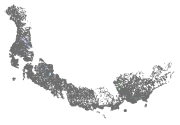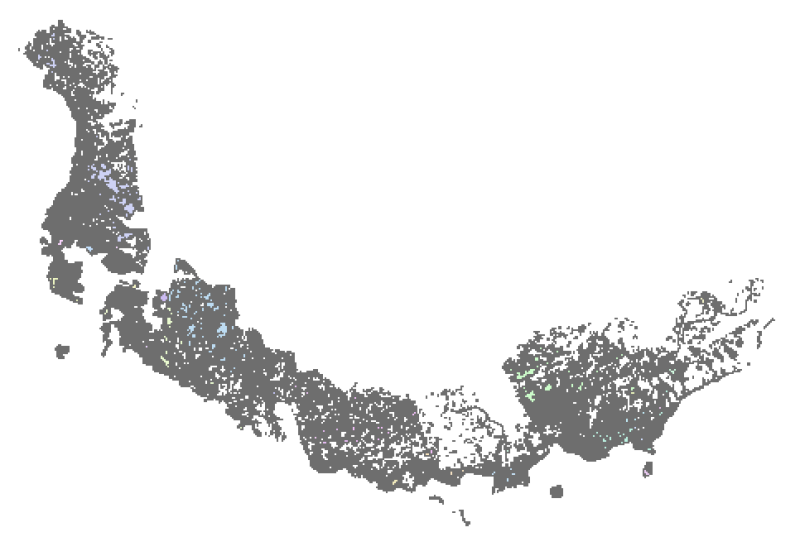2015 - Anthropogenic disturbance footprint within boreal caribou ranges across Canada - As interpreted from 2015 Landsat satellite imagery
As part of a scientific assessment of critical habitat for boreal woodland caribou (Environment Canada 2011, see full reference in accompanying documentation), Environment Canada's Landscape Science and Technology Division was tasked with providing detailed anthropogenic disturbance mapping, across known caribou ranges, as of 2015. This data comprises a 5-year update to the mapping of 2008-2010 disturbances, and allows researchers to better understand the attributes that have a known effect on caribou population persistence.
The original disturbance mapping was based on 30-metre resolution Landsat-5 imagery from 2008 -2010. The mapping process used in 2010 was repeated using 2015 Landsat imagery to create a nationally consistent, reliable and repeatable geospatial dataset that followed a common methodology. The methods developed were focused on mapping disturbances at a specific point of time, and were not designed to identify the age of disturbances, which can be of particular interest for disturbances that can be considered non-permanent, for example cutblocks. The resultant datasets were used for a caribou resource selection function (habitat modeling) and to assess overall disturbance levels on each caribou ranges. Anthropogenic disturbances within 51 caribou ranges across Canada were mapped. The ranges were defined by individual provinces and territories across Canada. Disturbances were remapped across these ranges using 2015 Landsat-8 satellite imagery to provide the most up-to-date data possible.
As with the 2010 mapping project, anthropogenic disturbance was defined as any human-caused disturbance to the natural landscape that could be visually identified from Landsat imagery with 30-metre multi-band imagery at a viewing scale of 1:50,000. A minimum mapping unit MMU of 2 ha (approximately 22 contiguous 30-metre pixels) was selected. Each disturbance feature type was represented in the database by a line or polygon depending on their geometric description. Polygonal disturbances included: cutblocks, mines, reservoirs, built-up areas, well sites, agriculture, oil and gas facilities, as well as unknown features. Linear disturbances included: roads, railways, powerlines, seismic exploration lines, pipelines, dams, air strips, as well as unknown features. For each type of anthropogenic disturbance, a clear description was established (see Appendix 7.2 of the science assessment) to maintain consistency in identifying the various disturbances in the imagery by the different interpreters.
Features were only digitized if they were visible in the Landsat imagery at the prescribed viewing scale. A 2nd interpreter quality-control phase was carried out to ensure high quality, complete and consistent data collection.
For this 2015 update an additional, separate higher-resolution database was created by repeating the process using 15-metre panchromatic imagery.
For the 30-metre database only, the line and poly data were buffered by a 500-metre radius, representing their extended zone of impact upon boreal caribou herds. Additionally, forest fire polygons were merged into the anthropogenic footprint in order to create an overall disturbance footprint.
These buffered datasets were used in the calculation of range disturbance levels and for integrated risk assessment analysis.
Basic view
Metadata Record Information
- File Identifier
- a71ab99c-6756-4e56-9d2e-2a63246a5e94 XML
- Date Stamp
- 2024-10-01T16:46:24.902Z
- Metadata language
-
eng; CAN
- Character set
- UTF8
- Hierarchy Level
- Dataset
https://www.canada.ca/en/environment-climate-change.html
Data identification
- Title
-
2015 - Anthropogenic disturbance footprint within boreal caribou ranges across Canada - As interpreted from 2015 Landsat satellite imagery
- Date (Publication)
- 2019-03-15
- Date (Creation)
- 2018-11-15
- Status
- On going
- Metadata language
-
eng; CAN
- Character set
- UTF8
- Topic category
-
- Environment
- Maintenance and Update Frequency
- Unknown
- Spatial representation type
- Vector
Keywords
- Theme
-
-
anthropogenic disturbance, boreal, forest, caribou, habitat, mapping, landcover, landuse
-
-
ECCC Information Category EN
-
-
Nature and Biodiversity
-
-
Government of Canada Core Subject Thesaurus
-
-
Ecosystems
-
-
Business Functions
-
-
Protect Species Well-Being
-
Develop Species Recovery / Management / Conservation Plans
-
-
Geography
-
-
National (CA)
-
-
external.theme.EC_Branch
-
-
Science and Technology Branch
-
-
external.theme.EC_Directorate
-
-
Wildlife and Landscape Science
-
-
external.theme.GC_Security_Level
-
-
Unclassified
-
- Use Limitation
-
Open Government Licence - Canada ( http://open.canada.ca/en/open-government-licence-canada )
- Access Constraints
- License
- Use Constraints
- License
- Begin Date
- 2015-04-01
- End Date
- 2015-10-31
Extent
))
Ref. system Reference Systems
- Reference system identifier
- https://epsg.io / EPSG:4326 /
Distribution
Distribution Formats
- Distribution format
-
-
FGDB/GDB
(
10
)
-
FGDB/GDB
(
10
)
https://www.canada.ca/en/environment-climate-change.html
Overviews


))
Provided by
